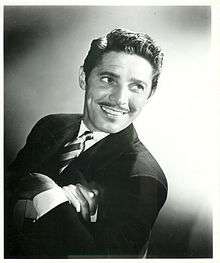Jean Sablon
| Jean Sablon | |
|---|---|
 Portrait of Jean Sablon in Hollywood in 1941. | |
| Born |
Jean Georges Sablon March 25, 1906 Nogent-sur-Marne, France |
| Died |
February 24, 1994 (aged 87) Cannes, France |
| Nationality | French nationality |
| Education | Lycée Charlemagne |
| Occupation | Singer, actor |
| Years active | 1923-84 |
| Known for | J'attendrai, C'est si bon, La Vie en rose, Les feuilles mortes, Sur le Pont d'Avignon, Melodie d'Amour, Syracuse, Je tire ma révérence, Vous qui passez sans me voir, C'est le printemps, Ce petit chemin |
| Style | Chanson |
Jean Sablon (Nogent-sur-Marne, 25 March 1906 - Cannes, 24 February 1994) was a French singer and actor.
Biography
The son of a composer, with brothers and sisters who had successful careers of their own in musical entertainment, Jean Sablon studied piano at the Lycée Charlemagne in Paris. He left before graduating to enroll at the Paris Conservatoire in order to concentrate on a vocal career. He started in the cabarets of Paris at the age of 17, and was subsequently accompanied on his first album by the pianist/composer Mireille, whose song "Couchés dans le foin" became a great success. Later, he partnered the wildly popular Mistinguett at the Casino de Paris and boosted his career considerably. He was the first cabaret singer to use a microphone in his stage act. In the 1920s he spent time in Brazil where his recordings remain extremely popular today.
In 1937, he won the Grand Prix du Disque for the song "Vous qui passez sans me voir", written for him by Charles Trenet and Johnny Hess. That same year, he went to the United States, where he sang on live radio broadcasts for CBS and made several records in the English language. On Broadway, he worked with luminaries such as Cole Porter and George Gershwin. He returned to Paris but, with the German occupation of France in World War II, he went back to America for the duration.
March 30, 1950, Jean Sablon records the first English version of C'est si bon in London with the lyrics of Jerry Seelen. June 26, 1950, Louis Armstrong recorded the song in New York City with Sy Oliver and his Orchestra and the song became a worldwide hit.
Jean Sablon became one of the most widely acclaimed male French singers, considered second only in overall lifetime popularity to Maurice Chevalier. His records sold in the millions around the world and he is frequently referred to as the French equivalent of America's Bing Crosby. During his career, he recorded with some of the world's top musicians, including Django Reinhardt and Stéphane Grappelli. Sablon is credited with arranging Reinhardt's debut in a fashionable cabaret in 1933. He is also recognized for his talents as a lyricist and a composer. Sablon appeared in a number of motion pictures and television films performing as a vocalist or pianist, his last being in 1984 when he sang "April in Paris" in Mistral's Daughter, the popular American TV miniseries filmed in France.
Jean Sablon died in Cannes in 1994 and was buried in the Cimetière du Montparnasse in Paris.
Personal life
Jean Sablon was the son of composer Charles Sablon and the brother of composer André Sablon and singer and actress Germaine Sablon. The actor Jacques Sablon was his nephew.
Respects
- On 30 April 2004 the allée Jean Sablon was inaugurated in the 16th arrondissement of Paris.
- On 7 September 2006 the promenade Jean Sablon was inaugurated along the Marne, in Nogent-sur-Marne, on the occasion of an exhibition for the centenary of Sablon's birth.
- On 10 April 2010 the allée Jean Sablon was inaugurated on the Promenade de la Croisette in Cannes.
- On 15 May 2015 the esplanade Jean Sablon was inaugurated in Théoule-sur-Mer.
Revues
- 1927 : Au temps de Gastounet, by Georges Gabriel Thenon, Théâtre des Bouffes-Parisiens.
- 1931 : Revue Argentine, by Manuel Romero and Bayon Herrera. Parade de femmes, by Henri Varna, Léo Lelièvre and Marc Cab, Le Palace. Paris qui brille, by Henri Varna, Léo Lelièvre and Earl Leslie, Casino de Paris.
- 1932 : Ces messieurs dames, by Francis Carco, Le Studio de Paris.
- 1934 : Femmes en folie, by Maurice Hermitte and Jean Le Seyeux, Folies Bergère.
- 1935 : Pirouette 35, by Fernand Rouvray and Max Eddy, Théâtre des Dix Francs.
Operettas
- 1924 : Madame, by Albert Willemetz, music by Henri Christiné, Théâtre des Bouffes-Parisiens.
- 1928 : Lulu, by Serge Veber, music by Georges Van Parys and Philippe Parès, Théâtre Daunou.
- 1929 : Vive Leroy, by Henri Géroule and René Pujol, music by Fred Pearly and Pierre Chagnon, Théâtre des Capucines.
- 1933 : Dix-neuf ans, by Jean Bastia, music by Pascal Bastia, Théâtre Daunou.
- 1936 : Le Chant des tropiques, by Louis Sauvat and Champfleury, music by Moyses Simons, Théâtre de Paris.
Musical theatre
- 1923 : La Dame en décolleté, by Yves Mirande and Lucien Boyer, music by Maurice Yvain, Théâtre des Bouffes-Parisiens.
- 1925 : Trois jeunes filles nues, by Yves Mirande and Albert Willemetz, music by Raoul Moretti, Théâtre des Bouffes-Parisiens.
Filmography
- 1924 : Madame Sans-Gêne by Léonce Perret.
- 1930 : Chacun sa chance by René Pujol and Hans Steinhoff.
- 1939 : La Grande Farandole by H. C. Potter.
- 1951 : Paris Still Sings by Pierre Montazel.
External links
- International Jose Guillermo Carrillo Foundation
- Jean Sablon at the Internet Movie Database
- Official website
- Jean Sablon at the Hall de la chanson
- Jean Sablon at the UniFrance Films
- Jean Sablon at Les Gens du cinéma
- Jean Sablon at the Cimetières de France et d’ailleurs